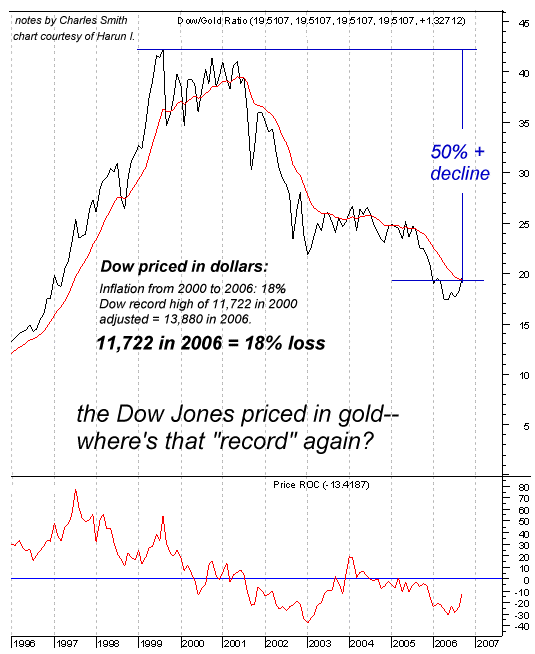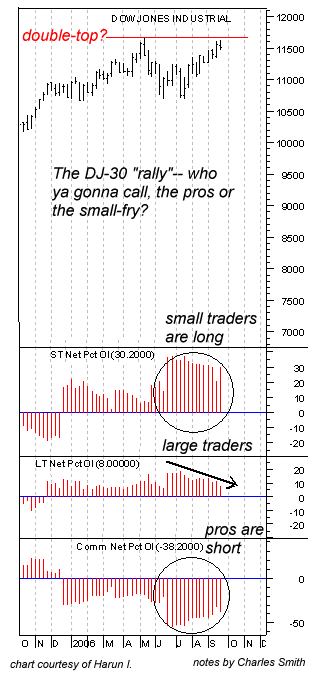

|
| weblog/wEssays archives | home | |
|
This Week's Theme: Trust/Confidence (October 2, 2006) We've got a fun and fact-filled week here at oftwominds.com, all centered on the theme of trust/confidence. My commitment to you, dear reader, remains the same: no ads (except spoofs) and a not quite predictable mix of content. OK, let's get to work. Internet friend S.P. asked me for my view on the U.S. stock market, and my response begins with this question: "How much confidence can we place in the data we are presented?" The short answer: as far as you can throw an Elephant (or for that matter, a Donkey.) Let's start with those utterly bogus new home sales. As Alan Abelson noted in his UP AND DOWN WALL STREET column in the current issue of Barrons: The only reason (new home) sales were higher, as Northern Trust's gimlet-eyed Asha Bangalore points out, is that there were ponderable downward revisions to the previous estimates of new home sales in May, June and July. If the original estimates for July were unrevised, August would have shown a decline of 2.1%, instead of a rise of 4.1%.Could this manipulation be any more blatant? Compare apples (current data) to oranges (revised data) or whatever it takes to conjure up a "positive-spin" housing sales report. The sales figures are bogus for another reason: cancellations are never recorded or deducted. With cancellation rates running at 30% - 40%, exactly how many of these "new home sales" actually close? No one knows, but it's certainly a much lower number than the sales number--as reported in Bloomberg: Simply put, cancellations are rising, and they aren't being captured in the aggregate statistics because of the way the survey is designed. Hence, sales are being overstated and inventories understated.Next up: that phony-baloney "Dow Jones Industrials record high." Nice--but what about the 18% inflation since the 11,722 record was reached in 2000? Rather conveniently forgotten, isn't it? Let's face it: this DJ-30 "record" is as bogus as they come. First go to the Bureau of Labor Statistics Inflation Calculator and plug in $1 in 2000 and you find that you need $1.18 in 2006 to equal that buck in 2000. Therefore, to reach an inflation-adjusted new high the Dow would need to rise above 13,880. Reaching the record of 11,722 in 2006, once adjusted for inflation, leaves us not with a record but an abysmal 18% decline in the value of our portfolio. But have your read even one mass-media pundit who mentions inflation in conjunction with this utterly fake "record"? 
Frequent contributor Harun I. has graciously supplied this chart of the Dow priced in gold rather than dollars. The "new record" story looks quite a bit different here. Priced in gold, the Dow has plummeted more than 50% from its Augsut 1999 record (in ounces of gold). So where's our new Dow record? I guess in the same Fantasyland where inflation is near zero. 
Harun was also kind enough to send along a chart of the Dow Jones Industrials with trader data. Here is his commentary, which I suggest you read closely: Here is the Dow Industrials with all three groups of traders as classified by the CFTC. What is important to note here is the level of net percent holdings by group. Commercials: 38.2% net short, Non-Commercial (Large Traders): 8% net long, Non-reportable (Small Traders) 30.2 % net long.There are a number of influential folks who would dearly like to see the "rally" extend to November 3 (for instance, those incumbents running for Congressional offices). But it remains to be seen if their pals will keep buying the "rally" to goose it along until the incumbents are duly re-elected on a platform of "lower gasoline prices and continued prosperity, as proven by the new Dow record high." Or, maybe even the "Plunge Protection Team" won't be able to maintain air pressure in this phony Dow "record." Note that the market historically drops 10% after the Fed's last interest rate increase (Cue the menacing music). The fact that the Dow failed to close above its previous "high" on three intraday attempts last week is also rather bearish. Speaking of gasoline prices: have any of you done this math? Decline in oil: $78 to $60/barrel, a drop of 23%. Average price drop in gasoline: 66 cents/gallon, or 33%. Isn't it interesting that gasoline dropped significantly more than the price of crude oil? "Market forces" at work? Yeah, sure, pal. As if the buyers of gasoline wouldn't have been thrilled with a mere 23% decline in gasoline prices. So why the extra 10% drop? The famous compassion and generosity of oil companies? (Hahahahahahaha....) Or could it be related to the rising popularity of office holders every time gas prices decline? Hmmm.... For more on this subject and a wide array of other topics, please visit my weblog. copyright © 2006 Charles Hugh Smith. All rights reserved in all media. I would be honored if you linked this wEssay to your site, or printed a copy for your own use. |
||
| weblog/wEssays | home |